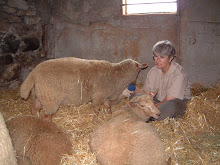While sheep have been used as a model for asthma and COPD (chronic obstructive pulmonary disease) in humans there is very little written about the condition in sheep itself except for anecdotal evidence that sheep grazing on kelp on the Scottish Islands are less susceptible to respiratory coughing etc. Something to do with the iodine levels.
We have one lamb (possible two) and one ewe that have what I am starting to believe is COPD. When they are housed inside, especially if the ammonia levels increase or dust levels are higher than desirable, they have upper respiratory tract congestion, coarse breathing and coughing. These conditions do not really respond to antibiotic treatment but respond better to improvements in air quality.
I know that the one lamb had a very difficult time during birth, was a backwards presentation and had problems for the first few days. I am guessing that the lamb may have aspirated some fluid during birth and have some lung damage. I think that has left this animal more vulnerable to air quality issues. He spent the majority of the summer housed outside with access to airy shelters. His breathing difficulty only arrived once he was brought back into the barn.
This morning the lamb's breathing was very rough. I treated him with a wind aid treatment with potassium iodide, eucalyptus oild and pepperment oil. I then put down a heavy layer of fresh bedding. Within minutes his breathing was back to normal. He will be moved into a clean stall with better ventilation.
A second lamb that has mild respiratory problems also underwent a difficult birth.
I have a mature ewe with a similar condition: fine when housed outside but chronic breathing problems that does not respond to antibiotic treatment when housed inside. The condition improves with improved air quality. We bought the ewe as a mature animal so I am not sure if she was the result of a difficult birth but I would not be surprised.
More than even I am convinced that animals are healthier when housed outside. While our barn structure does not allow for huge improvements in air movement (low ceiling bank barn), we are going to do what we can to move more air through the builing and minimize the time the animals are inside.
I am also convinced that difficult deliveries, especially backwards presentations predispose the lambs to chronic respiratory vulnerabilities. Unless a lamb is extremely valuable those that underwent a difficult delivery will be slated as market lambs. Ewes that have chronic lambing problems will be culled.
I would love to hear from others that think they may have seen COPD in their sheep.
TTFN,
Laurie
Wednesday, November 16, 2011
Subscribe to:
Post Comments (Atom)


I have been shepherding a flock of Leicester sheep since 1997. Over the years, I have had occasional cases of pneumonia. I agree with your conclusion that environment contributes to the condition. Since we began giving our sheep access to the out of doors all winter, the incidence of lung congestion has been reduced. When it does occur, we treat with long acting antibiotics like Biomycin or Nuflor. I cannot correlate the breathing difficulties with difficult births but what you are suggesting does make some sense. There is no question that only trouble-free lambs should be retained - not always easy to do however.
ReplyDeleteThanks for the comment Janice. Yes you are right it is hard to always select for trouble free lambs especially if you only have a few animals.
ReplyDeleteDo you know John Campbell? He is in Osgoode and has Border Leicesters.